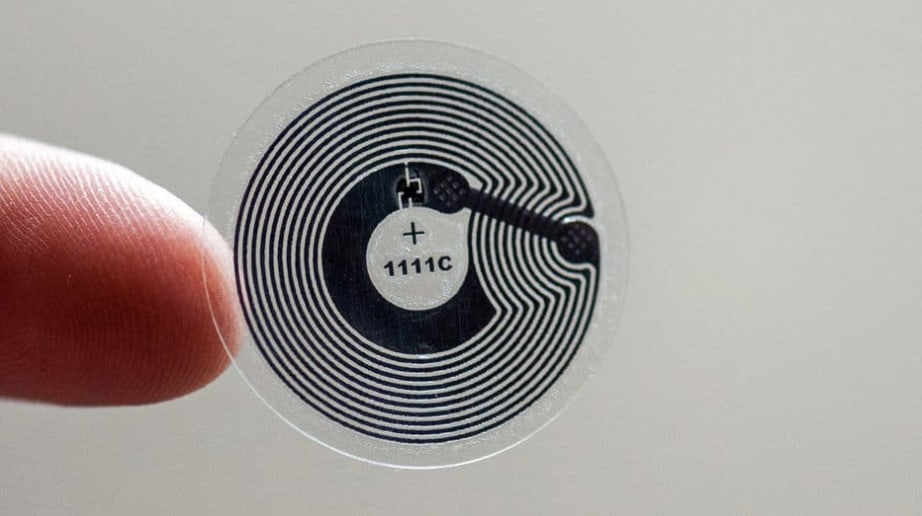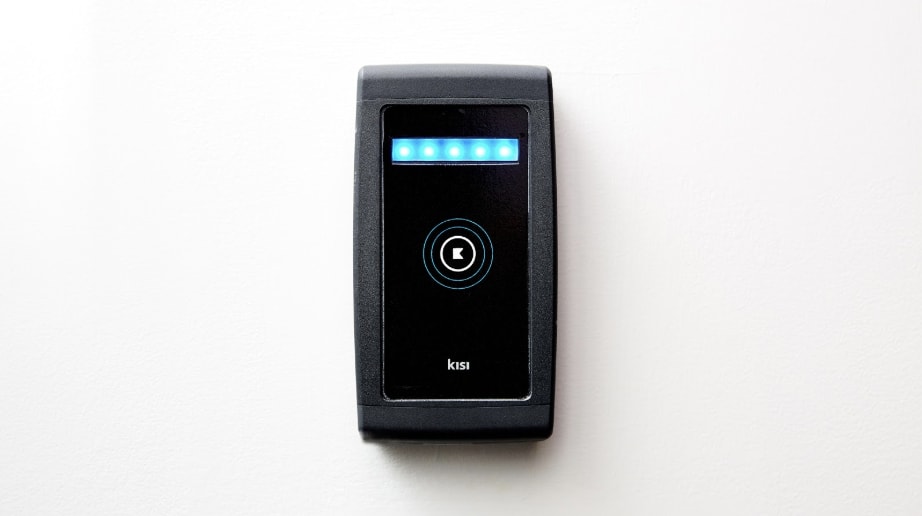We’ve covered general mobile unlocks for access control in this article, including the overall field of mobile apps for access control and an overview of the various ways to unlock a door reader with a mobile app. In this article, we’ll dive deeper into the world of Android and explore the different functionalities and use-cases for using your Android phone app to unlock a door reader.
How does NFC work to unlock doors on Android phones?
The primary technology behind Android unlocks is the NFC standard of RFID communication. For a deeper dive into how this tech works, check out our article on the subject.
Mobile Tap to Unlock With NFC
Almost all modern Android phones come with an NFC chip installed. It takes up little to no space at all—here you’ll find a picture of a standard NFC tag you might have in your phone. While the surface area is bigger, it’s incredibly thin and can fit inside any phone (the surface area can be reduced as well, at the cost of some strength of signal).

On the other side of the equation, most modern access control readers have NFC chip reading antennas. When an Android device approaches the NFC reader, they communicate with each other and the reader authenticates the device, granting access to the user. For more details on this process, consult the NFC article referenced above.

Before moving on, though, a cool feature worth mentioning is that the NFC chip doesn’t require internet: Even for mobile Android unlocks, you don’t need to be online to unlock your reader using the NFC chip in your phone.
Can other NFC applications interfere with access control?
From the innovation of Android Pay, to the versatility of Android NFC Tools, to clever, fun applications like NFC puzzle alarm clocks, there are tons and tons of apps out there that use the NFC capabilities of Android phones. You might wonder, then, if the apps interfere with each other.
For example, when you’re trying to unlock a door reader, how does your phone know not to activate its Android Pay feature? Could this cause any security concerns, with your phone transmitting confidential credit card information to the reader?

Before elaborating more on this, rest assured that the answer to that second question is a firm ‘no.’ There is no way for a reader that is not approved by your bank to read your credit card information via the NFC tag.
Regardless, though, interference is not an issue that you have to worry about. In the NFC article on this page, you’ll find a more detailed description of the technology, but for the purposes of this discussion, it’s enough to know that the NFC chip pretty much only transmits identification information.
The amount of data that NFC can transmit is pretty limited, so all the chip does is pass along its unique ID (with some encryption, of course) and the reader does the rest. No interference equals no headaches for you!
What role does Bluetooth play?
Android phones have a Bluetooth chip, in addition to an NFC chip, much like iPhones. However, unlike iPhones (where the NFC is chip is proprietary) and third party apps don’t have access, Androids allow any app on the phone to access the chip.
For the purposes of tap to unlock, NFC is actually better than BLE (Bluetooth Low Energy), as the communication can be established more quickly and information transmitted more reliably over those short distances. For this reason, access control apps like Kisi choose to use NFC when it’s available for the tap to unlock functionality on the readers.
However, that’s not to say that the Bluetooth chip remains unused. Given its availability, many apps will use it as well for increased functionality and a better user experience.
BLE Fencing
The primary way that apps, like Kisi, use an Android’s Bluetooth chip is through Bluetooth fencing. Using a technology called BLE Beacon, Bluetooth transmitters can establish a geofence around them where their signal can reach. For BLE (Bluetooth Low Energy) devices, this is limited to around 50 meters, but can be artificially reduced by programming it to a shorter distance.
The transmitter (reader, in this case) will continually transmit a signal and, as soon as it picks up another Bluetooth chip, establish a weak communication with it just to determine its approximate distance. If it judges the device to be within the accepted range then it will allow certain functions to be performed.
For access control apps, like Kisi, this can be used for limiting the range of swipe to unlock. As an admin for a Kisi ‘place’, you can activate two different Bluetooth Beacon fences—on the controller and on the reader. The controller will use Wi-Fi, but the reader will use its Bluetooth Beacon capabilities to only allow devices within a preset Bluetooth range to use the swipe-to-unlock functionality.

What are the particularities of Android mobile unlocks?
There are many features that distinguish Android mobile unlock functionality from iOS. While iOS is covered more in depth in another article, here we’ll discuss some of the quirks of Android apps, as well as some of their more intuitive and powerful features.
Screen Unlock Requirement
Unlike iPhones, where you can use functionalities like Apple Pay and general NFC capabilities without unlocking your phone, Android phones require you to unlock your screen to access most NFC capabilities.
This is not a particularly restrictive feature, and actually is used for security reasons; NFC codes are encrypted, but RFID signals are still sometimes vulnerable to snooping, so this prevents eavesdropping on the phone while it’s in your pocket. It does make the unlocking process a bit more involved and annoying, though.
Customizability
As opposed to iOS apps, that have greater restrictions on customizability and developer power, Android apps more easily lend themselves to customized, semi white-labeled apps and use of native Android features, like the NFC chip (discussed above).
In terms of user interface, many modern access control companies realize that company branding is incredibly important, so on Android they will allow those companies to customize the app interface to reflect their own color scheme and general aesthetic.

Android Wear
Wearable technologies are incredibly hot in the Internet of Things these days, with everything from Apple Watches and FitBits to that famously failed Google Glass experiment. Android Wear watches are following in this trend, with many new and flashy models appearing every year. Much like Android phones themselves, every good smart watch is equipped with NFC and Bluetooth chips and access control apps can leverage these for unlocking doors.
You can get unlock notifications to a linked Android Wear watch, in Kisi’s Android app, and use the watch to activate the swipe to unlock functionality to open your doors, all without having to take your phone out of your pocket!
Third-Party NFC Card Enablement
With Android phones, you actually have the option of enrolling your own third-party cards to unlock Kisi door readers using the NFC tools Android app. You can read more about this capability on Kisi’s website, as well as check out a more [in-depth article (LINK TO 3RD PARTY CARDS ARTICLE)] on third-party NFC cards.
Concluding Thoughts
Thanks to their versatility and customizability, Android phones are an exciting platform for app developers to tinker with. Access control companies have taken full advantage of this and all such future-proof companies have Android apps, with features like tap to unlock using NFC, swipe to unlock using BLE fencing, and cool android features like Android Wear compatibility and personalized branding.
Save time. Enhance security.
Modernize your access control with remote management and useful integrations.
Continue learning

